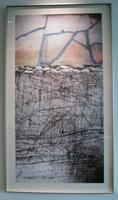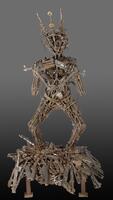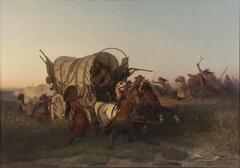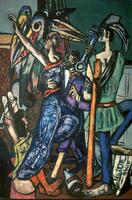Pioneer Literature Tour
Destruction, Survival and Rebuilding as Portrayed in Art and LiteratureWe will be exploring these themes and may also touch on themes of betrayal and identity.The goal of the writer is to create an image using language. The visual arts provide the viewer with an image that may document an event and/or provoke emotions and interpretations. Unless we are an eye witness (or victim) of a devastating event all of our information comes through the eyes of someone else. All media, visual or print has a point of view, (for example, the areal view of the near drowning in Aftermath). These points of view influence our understanding and reaction to the scene, even if the artist's goal is documentation.
1. Emigrant Train
Literature Reference: "The Lone Ranger and Tonto Fist Fight in Heaven" by Sherman Alexie
In his darkly comic short story collection, the author brilliantly weaves memory, fantasy, and stark realism to paint a complex, grimly ironic portrait of life in and around the Spokane Indian Reservation. These twenty-four interlinked tales are narrated by characters raised on humiliation and government-issue cheese, and yet are filled with passion and affection, myth and dream. There is Victor, who as a nine-year-old crawled between his unconscious parents hoping that the alcohol seeping through their skins might help him sleep, Thomas Builds-the-Fire, who tells his stories long after people stop listening, and Jimmy Many Horses, dying of cancer, who writes letters on stationary that reads "From the Death Bed of Jimmy Many Horses III," even though he actually writes then on his kitchen table. Against a backdrop of alcohol, car accidents, laughter, and basketball, Alexie depicts the distances between Indians and whites, reservation Indians and urban Indians, men and women, and mostly poetically between modern Indians and the traditions of the past.
2. Apsara Apsara-relates to dictatorship, message of peace (Literature reference: In the Time of the Butterflies, Alvarez) Apsara Warrior(2003) -an over life-sized female divinity figure fabricated with detonated AK47s. Brought to life by contemporary Cambodian artist Ouk Chim Vichet (born 1981 in Phnom Penh), this apsara warrior is posed atop a pile of discarded guns and holds a broken rifle in her hands. The piece originated out of the Peace Arts Project Cambodia, which was funded in part by the European Union Assistance on Curbing Small Arms and Light Weapons in Cambodia and designed to promote non-violence and young Cambodian artists. ( Leader of Khmer Rouge, Pol Pot led to the death of two million Cambodians, a quarter of Cambodia's population at the time, through executions, starvation and forced labor (1975 - 1979). This was considered a genocide. Pol pot's reign ended with the invasion of Cambodia by Viet Nam, which occupied it for ten years. This is why there were so many guns that needed to find a new function. In 2003, Ouk was one of 23 sculpture students from the Royal University of Fine Arts in Phnom Penh selected to create work from decommissioned weapons-mines and small arms-for the project. He chose the traditional and popular apsara figure- encountered in ancient temple carvings throughout Cambodia as a graceful, celestial dancer who performed to honor the gods and ancestors-for her star power and reputation for gentleness and peace. "This work of art shows that apsara, in addition to her many images in many temples, is also a symbol of women of the world who are brave and struggle hard to rid the world of war and all fearful things which threaten human life," said the artist.
3. Aftermath: Landscapes of Devastation
From Jennifer M. Freiss, Assistant Curator of Photography
"Photographs of atrocities and disasters are often expected to be documentary and unmediated, serving as didactic evidence of a terrible event and its aftershocks. However, photographs also have the power to shape public consciousness and perpetuate certain memories of a catastrophe; a single photograpth can become symbolic of much more than confirmation that an event occurred. Indeed, the images on view remind us that disaster is often a collective experience that can tear apart the seams of a culture's social fabric and impact societies well after an event."
Notes from Jennifer's presentation:
-Photos are arranged by the length of time after the event they were taken.
-Photos cause us to question how we respond to the suffering of others.
-Can we find beauty in ruins? Does the length of time after a catastrophe change our reaction to a photo?
Additional points:
"Church at Wounded Knee" can be related to "Emigrant Train".
The destroyed French village, left as a memorial can be related the the Beckmann and Giacometti.
In general the ideas of devestation, survival and redemption can be discussed. Also, the types of disaster: caused by others, caused by nature or caused by ourselves can be explored in the exhibit.
Literature reference "Between Shades of Gray" by Ruta Sepetys
In 1941, fifteen-year-old Lina, her mother, and brother are pulled from their Lithuanian home by Soviet guards and sent to Siberia, where her father is sentenced to death in a prison camp while she fights for her life, vowing to honor her family and the thousands like hers by burying her story in a jar on Lithuanian soil. Based on the author's family, includes a historical note.
Literature reference: "The Kite Runner" by Khaled Hosseini
The unforgettable, heartbreaking story of the unlikely friendship between a wealthy boy and the son of his father's servant, The Kite Runner is a beautifully crafted novel set in a country that is in the process of being destroyed. It is about the power of friendship, the price of betrayal, and the possibility of redemption; and an exploration of the power of fathers over sons their love, their sacrifices, their lies. A sweeping story of family, love, and friendship told against the devastating backdrop of the history of Afghanistan over the last thirty years,
4. Red Circle
These posters appeared in Japanese government-sponsored trade fairs, cultural festivals and sports events. The goal of the posters was to increase understanding of Japanese culture. World opinion of Japan was mixed after WWII. Japan wanted to improve its image with other countries.
The red circle of the Japanese flag is easily recognizable and used frequently.
A walk past "Samurai" in the Japanese Gallery may stimulate discussion of the image of Japan before WWII and after.
5. Max Beckmann, "Begin the Beguine" and Giacometti, "Standing Figure"
Giacometti wanted to show people's personalities in the simplest way. He stripped away all details to show inner feelings. This makes it harder to look at but makes the artist's point more clear. Giacometti's work reacts to WWII and the Holocaust. Does the loneliness and isolation portrayed by this piece parallel people reacting to the horrors of the war?
Max Beckmann, "Begin the Beguine" Beckmann was German and left Germany for Amsterdam and eventually came to the USA. This painting has many symbols of his feelings about the war, his leaving the country for the USA. The title is from a song popular in 1935. The Beguine was a dance and represented Beckmann's new start in the USA. The man in the painting is Beckmann. He was not really wounded or lost a leg, it symbolizes his emotional state not his physical state. The woman with no hands represents the injured Europe. Lady Liberty represents the USA and is uninjured. The man to the right symbolizes England. What does the key symbolize? Pelicans are symbols of self-sacrifice because they peck at their chests to produce blood to feed their young. Why is it here?
| Literature Reference: "Purple Hibiscus" by Chimamanda Adichie |
In the city of Egunu, Nigeria, fifteen year-old Kambili and her older brother Jaja lead a somewhat cloistered life. Their father is a wealthy businessman, they live in a beautiful home, and attend private school. But, through Kambili's eyes, we see that their home life is anything but harmonious. Her father, a fanatically religious man has impossible expectations of his children and his wife, and if things don't go his way he becomes physically abusive. Not until Kambili and Jaja are sent away from home for the very first time to visit their loving aunt, does Kambili's world begin to blossom. But when a military coup threatens to destroy the country, the tension in her family's home escalates, and Kambili must find the strength to keep her loved ones together.
Rate this Resource
AVG: 0 | Ratings: 0
& Author Notes
Creative Commons by-nc-saLast Updated
January 23, 2018 12:37 p.m.Report
Reporting Policy






